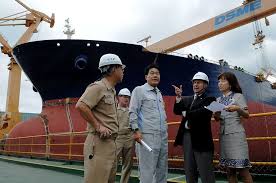Accelerating US Shipbuilding: The Need for International Collaboration
The growing need to speed up shipbuilding programs in the United States is leading to consideration of overseas partnerships. The expansion of naval vessels and submarines is critical, and to meet tight deadlines, building some components abroad has become a viable strategy.
Which Countries Are on the US Radar?
Experts have pointed to specific allies that might offer key assistance in naval shipbuilding. Canada comes up frequently for its capability in offshore work, as well as specialized ship repair and maintenance services that can support fleets. Meanwhile, Finland stands out with its expertise in producing icebreakers—vessels vital to navigating icy waters—addressing a long-standing challenge for the United States Coast Guard.
| País | Shipbuilding Contribution | Impacto logístico |
|---|---|---|
| Canadá | Offshore shipbuilding, repair and maintenance | Supports fleet readiness, enabling continuous operations and reducing downtime |
| Finland | Leading producer of heavy icebreakers | Strengthens polar region logistics and maritime mobility in icy conditions |
Why These Partnerships Matter
The US shipbuilding industry is facing a crunch as it tries to reduce wait times and ramp up production for defense vessels. Collaborating with capable allies not only spreads the burden but also injects diverse technical know-how into naval logistics. For instance, Canada’s experience with offshore ships plays directly into sustaining fleets, a critical factor in defense logistics. Icebreakers coming from Finland cover a vital gap in Arctic operations, providing crucial access through frozen waters that influence strategic and commercial shipping routes alike.
Supply Chain and Logistics Considerations
Bringing in foreign shipbuilding partners does more than boost production capacity; it reshuffles the supply chain and freight flow both regionally and globally. These partnerships demand tight coordination of component shipments, scheduling of assembly phases across countries, and management of bulky cargo—particularly for large vessels. It’s a complex ballet of international forwarding, dispatch, and container handling that underscores the importance of reliable logistics networks. Platforms like GetTransport.com are invaluable here, simplifying the moving and relocation of large items like components and finished ships, ensuring smooth cargo deliveries and streamlined haulage operations.
Historical Context and Strategic Insights
The United States has a storied history of naval development but often looks outward when unexpected demands surge. Working with close allies to expedite ship repairs or construct specialized vessels is a strategic move to ensure fleet readiness and address unique environmental challenges. These collaborations reflect a broader logistics trend where integration and shared resources allow for more flexible and resilient supply chains, vital when dealing with bulky, high-value freight like naval vessels and their parts.
Logistics Landscape and Challenges in Shipbuilding Collaboration
International shipbuilding partnerships introduce complexity to the shipping and transport sectors. Coordination of shipments over long distances, customs compliance, and timely delivery require meticulous planning. Especially when dealing with large freight items such as heavy icebreakers or vessel components, challenges around container handling and palletizing become even more pronounced. Efficient logistics hubs and reliable transport routes facilitate this international cooperation, keeping schedules and budgets intact.
Logistics Considerations Table: What to Keep in Mind
| Aspecto | Factores clave | Impact on Delivery |
|---|---|---|
| Freight Size | Bulky ship parts and vessels require specialized equipment | Demand for adaptable transport modes and loading/unloading gear |
| Customs & Regulations | Cross-border shipping mandates compliance with multiple jurisdiction rules | Possible delays if documentation or coordination lacks precision |
| Timelines | Shipbuilding deadlines pressure tight freight schedules | Logistics flexibility and proactive planning are critical |
| Modos de transporte | Combining sea, land, and possibly air freight for components | Multi-modal logistics optimize delivery speed and safety |
Bridging Shipbuilding and Global Logistics
When huge naval components cross international borders, they ripple through the shipping and forwarding sectors. Efficient coordination of parcel and pallet shipments, proper selection of container sizes, and clear communication between freight forwarders, customs brokers, and haulers are vital. Here, modern logistics platforms shine by offering transparent, affordable solutions for heavy and oversized cargo transport—whether moving vessels themselves or key parts of them.
Among available options, GetTransport.com stands out by providing a global network of transport providers to book cost-effective, reliable cargo shipping. Whether you’re handling complex freight like shipbuilding materials or simpler home and office moves, the platform supports diverse needs with options for large, bulky, or specialized freight transport — all with user-friendly booking and price transparency.
Making a Strong Case for Integrative Logistics
It’s often said that “the proof is in the pudding,” and while reviews and feedback about international shipbuilding partnerships and their logistic feats provide useful insights, nothing compares to firsthand experience. With GetTransport.com offering competitive prices across worldwide logistics services, clients can confidently plan shipments without fearing hidden costs or reliability issues. The convenience and transparency built into such a service offer peace of mind, especially when juggling complex cargo like naval components.
Book your freight transport with GetTransport.com to enjoy reliable, affordable shipping solutions tailored to your needs.
Wrapping Up: The Future of US Shipbuilding and Freight Forwarding
In sum, as the United States seeks to boost its naval shipbuilding capabilities quickly and efficiently, alliances with countries like Canada and Finland play a fundamental role. These partnerships bring critical skills in ship repair and icebreaker production, addressing specific operational challenges while complicating the global logistics puzzle. Managing the haulage and dispatch of large, heavy shipments across borders highlights the evolving nature of international freight and liner services.
For logistics and shipping sectors, this means adapting to increasingly intricate supply chains involving bulky, specialized cargo, powered by forward-thinking platforms such as GetTransport.com. Integration of global shipping networks, reliable delivery schedules, and cost-effective forwarding options will continue to be game changers in managing these demanding logistics scenarios. Ultimately, these developments not only strengthen the naval fleet but also serve as a microcosm of growing interdependence in global cargo transport and freight management.

 Exploring Global Collaboration in US Shipbuilding: Allies and Opportunities">
Exploring Global Collaboration in US Shipbuilding: Allies and Opportunities">